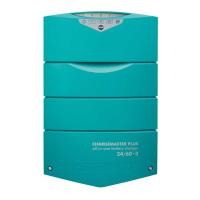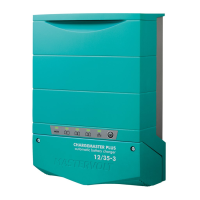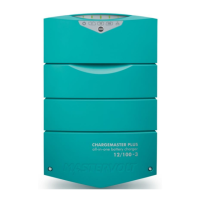BATTERIES GENERATE EXPLOSIVE
GASES DURING NORMAL BATTERY
OPERATION. FOR THIS REASON, IT IS OF
UTMOST IMPORTANCE THAT EACH TIME
BEFORE USING THE ChargeMaster Plus,
YOU READ THIS MANUAL AND FOLLOW
THE INSTRUCTIONS EXACTLY.
2 To reduce risk of battery explosion, follow
these instructions and those published by
battery manufacturer and manufacturer of any
equipment you intend to use in vicinity of the
battery. Review cautionary marking on these
products and on engine.
3 DANGER: To reduce the risk of
explosion – Never use the ChargeMaster
Plus in situations where there is danger of
gas or dust explosion or area in which
ignition-protected equipment is required.
2.3 Personal precautions
1 Consider having someone close enough by to
come to your aid when you work near a lead-
acid battery.
2 Have plenty of fresh water and soap nearby in
case battery acid contacts skin, clothing, or
eyes.
3 Wear eye and clothing protection. Avoid
touching eyes while working near battery.
4 If battery acid contacts skin or clothing, wash
immediately with soap and water. If acid enters
eye, immediately flood eye with running cold
water for at least 10 minutes and get medical
attention immediately.
5 NEVER smoke or allow a spark or flame in
vicinity of battery or engine.
6 Be extra cautious to reduce risk of dropping a
metal tool onto battery. It might spark or short-
circuit battery or other electrical part that may
cause explosion.
7 Do not wear watches, bracelets, necklaces or
other metal objects when working on batteries.
2.4 Warnings regarding the use of batteries
1 Only use the ChargeMaster Plus for charging
Lead-Acid or lithium-ion batteries and the
supply of consumers attached to these
batteries, in permanent systems. Do not use
ChargeMaster Plus for charging dry-cell
batteries that are commonly used with home
appliances. These batteries may burst and
cause injury to persons and damage to
property. Make sure lithium-ion batteries used
for this charger are certified to IEC standards.
2 NEVER charge non-rechargeable batteries.
3 NEVER charge a frozen battery.
4 Excessive battery discharge and/or high
charging voltages can cause serious damage
to batteries. Do not exceed the recommended
limits of discharge level of your batteries.
5 If it is necessary to remove a battery, always
remove grounded terminal from battery first.
Make sure all accessories are off, so as not to
cause an arc.
6 Be sure that the area around battery is well
ventilated while battery is being charged. Refer
to the recommendations of the battery
manufacturer.
7 Batteries are heavy! It may become a projectile
if it is involved in an accident! Ensure adequate
and secure mounting and always use suitable
handling equipment for transportation.
2.5 Charger location
1 Never place charger directly above battery
being charged; gases from battery will corrode
and damage charger.
2 Never allow battery acid to drip on charger
when reading electrolyte specific gravity or
filling battery.
3 Do not operate charger in a closed-in area or
restrict ventilation in any way.
4 Do not set a battery on top of charger.
2.6 DC connection precautions
1 Connect and disconnect DC output clips only
after setting any charger switches to
“off” position and removing AC cord from
electric outlet. Never allow clips to touch each
other.
2 Attach clips to battery and chassis as indicated
in section 2.7, steps 5 and 6, and 2.8 steps 2
through 4.
2.7 When battery is installed in vehicle
A SPARK MAY CAUSE BATTERY EXPLOSION.
To reduce risk of a spark near battery:
1 Position AC and DC cords to reduce risk of
damage by hood, door, or moving engine part.
2 Stay clear of fan blades, belts, pulleys, and
other parts that can cause injury to persons.
3 Check polarity of battery posts. POSITIVE
(POS, P, +) battery post usually has larger
diameter than NEGATIVE (NEG, N,–) post.
4 Determine which post of battery is grounded
(connected) to the chassis. If negative post is
grounded to chassis (as in most vehicles), see

